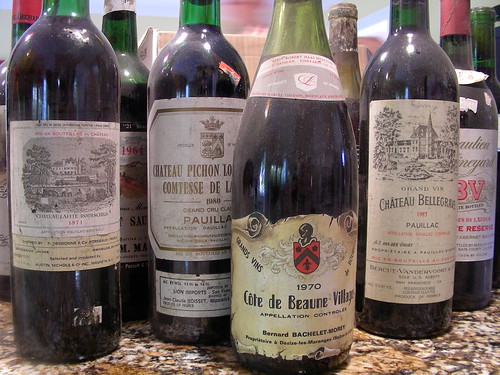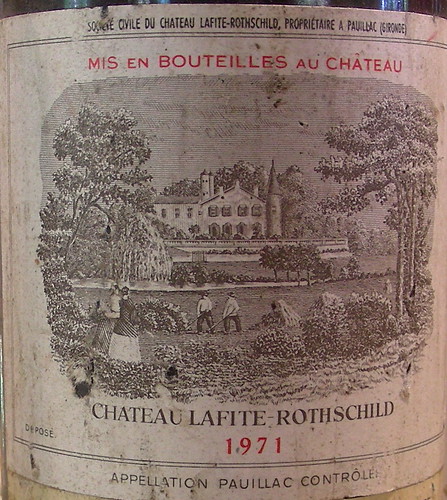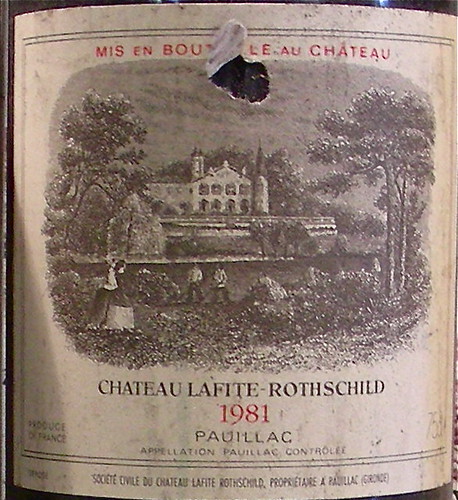And that's what we did the other day: we selected twenty bottles that looked most promising, opened them —which was by far the hardest task— and tried them. We were all hoping that some of the wines would still be good and I have to say that each bottle was opened religiously. But sadly, half of the wines were simply not drinkable and some others were drying out with light bodies and fading aromas. But miraculously, we also found a handful of treasures.

Here they are:
•
 1979 Beaune-Grèves Château de Meursault: the Beaune-Grèves appellation is a Premier Cru located on a hillside facing the town of Beaune. Its name probably comes from the French word graviers (small pepples) due to the presence of small gravels and sand mixed with clay in the soil. The wines from Beaune-Grèves are known for their elegance and finesse. The estate of Château de Meursault comprises 60 hectares of vines, all situated in the Côte de Beaune, around the towns of Aloxe Corton, Savigny-les-Beaune, Beaune, Pommard, Volnay, Meursault and Puligny-Montrachet. The wine had an amber-brick color and a fragrant, slightly smoky nose of dried cherry. The palate was fresh and well-balanced with a light finish of dried herbs, truly delicious!
1979 Beaune-Grèves Château de Meursault: the Beaune-Grèves appellation is a Premier Cru located on a hillside facing the town of Beaune. Its name probably comes from the French word graviers (small pepples) due to the presence of small gravels and sand mixed with clay in the soil. The wines from Beaune-Grèves are known for their elegance and finesse. The estate of Château de Meursault comprises 60 hectares of vines, all situated in the Côte de Beaune, around the towns of Aloxe Corton, Savigny-les-Beaune, Beaune, Pommard, Volnay, Meursault and Puligny-Montrachet. The wine had an amber-brick color and a fragrant, slightly smoky nose of dried cherry. The palate was fresh and well-balanced with a light finish of dried herbs, truly delicious!•
 1986 Château Font Villac: the wine is a Grand Cru from the Saint Emilion appellation and most likely a Merlot-Cabernet Franc blend. The year 1986 was a great vintage in Bordeaux. While the weather was hot and dry during the summer, mid-September rains tempered the drought-like conditions and helped vines reach full maturity. The wine had a deep brick-orange color and a sweet nose of blackberries. The palate was not overly complex but smooth, round, and pleasant.
1986 Château Font Villac: the wine is a Grand Cru from the Saint Emilion appellation and most likely a Merlot-Cabernet Franc blend. The year 1986 was a great vintage in Bordeaux. While the weather was hot and dry during the summer, mid-September rains tempered the drought-like conditions and helped vines reach full maturity. The wine had a deep brick-orange color and a sweet nose of blackberries. The palate was not overly complex but smooth, round, and pleasant.•
 1980 Château Pichon Longueville Comtesse de Lalande: Château Pichon Longueville Comtesse de Lalande is a classified second-growth from Pauillac. The property uses a blend of 45% Cabernet Sauvignon, 35% Merlot, 12% Cabernet Franc and 8% Petit Verdot, which has an unusually high proportion of Merlot for a Pauillac. Therefore, the wine tends to be more fleshy and softer than wines from the other Pauillac properties. The 1980 vintage was cool and wet in Bordeaux. Growers were able to delay their harvest until the weather began to improve at the end of September but rains returned in the middle of October during the harvest. Many wines from this vintage were light and diluted, the best results being from producers that made a strict grape selection and picked exceptionally late. The wine had a light-to-medium red color and a seductive nose of berries and flowers. On the palate, it was smooth and savory with an elegant and spicy finish.
1980 Château Pichon Longueville Comtesse de Lalande: Château Pichon Longueville Comtesse de Lalande is a classified second-growth from Pauillac. The property uses a blend of 45% Cabernet Sauvignon, 35% Merlot, 12% Cabernet Franc and 8% Petit Verdot, which has an unusually high proportion of Merlot for a Pauillac. Therefore, the wine tends to be more fleshy and softer than wines from the other Pauillac properties. The 1980 vintage was cool and wet in Bordeaux. Growers were able to delay their harvest until the weather began to improve at the end of September but rains returned in the middle of October during the harvest. Many wines from this vintage were light and diluted, the best results being from producers that made a strict grape selection and picked exceptionally late. The wine had a light-to-medium red color and a seductive nose of berries and flowers. On the palate, it was smooth and savory with an elegant and spicy finish.•
 1971 Château Lafite-Rothschild: Château Lafite-Rothschild is maybe the most famous property in Bordeaux and one of the four classified first growth wines. Located in Pauillac, the Lafite vineyard is one of the largest in the Médoc planted with 70% Cabernet Sauvignon, 25% Merlot, 3% Cabernet Franc, and 2% Petit Verdot. The 1971 vintage is characterized by a small crop size and forward and flattering wines upon release, thanks to a cold, damp spring followed by a warm and sunny summer. The wine had a light orange color, a subtle nose, and a light-bodied, lean palate with notes of buttermilk and earthy flavors on the finish.
1971 Château Lafite-Rothschild: Château Lafite-Rothschild is maybe the most famous property in Bordeaux and one of the four classified first growth wines. Located in Pauillac, the Lafite vineyard is one of the largest in the Médoc planted with 70% Cabernet Sauvignon, 25% Merlot, 3% Cabernet Franc, and 2% Petit Verdot. The 1971 vintage is characterized by a small crop size and forward and flattering wines upon release, thanks to a cold, damp spring followed by a warm and sunny summer. The wine had a light orange color, a subtle nose, and a light-bodied, lean palate with notes of buttermilk and earthy flavors on the finish.•
 1981 Château Lafite-Rothschild: the 1981 vintage produced wines of medium-weight, well-balanced and graceful. July was a cool month but August and September were hot and dry. It could have been an outstanding year had it not been for the heavy rains that fell just before the harvest. The wine had a light red color and a subtle nose of dried herbs. On the palate, it had more body and fruit than the 1971 with smoky spices on the finish.
1981 Château Lafite-Rothschild: the 1981 vintage produced wines of medium-weight, well-balanced and graceful. July was a cool month but August and September were hot and dry. It could have been an outstanding year had it not been for the heavy rains that fell just before the harvest. The wine had a light red color and a subtle nose of dried herbs. On the palate, it had more body and fruit than the 1971 with smoky spices on the finish.So did you guess my favorite wines? Hint: I had two.
Technorati tags: wine food & drink
No comments:
Post a Comment